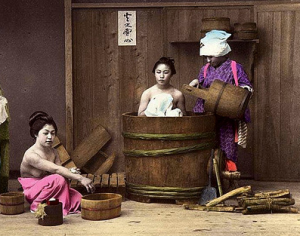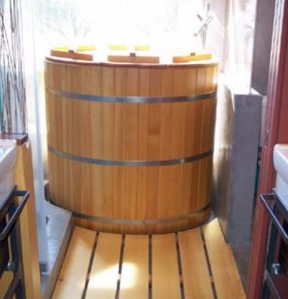I was in Munich about ten years ago and the bath store across the street from the hotel had a Japanese soaking tub in the window. My husband lived in Japan for a short time in the 80s and remarked that these deep wooden tubs were so fantastic he was surprised that they were not being sold in the states. The one pictured here is produced by Rapsel, an italian bath manufacture. It is modeled after a Japanese-style soaking tub, but because it is made in Italy, it is not a true Japanese, or Ofuro-style, tub.
According the history of Japanese soaking tubs, they were not actually used to wash oneself, but to benefit from the rejuvenating experience of being immersed up to your chin in hot water. The aromatic woods that these tubs are made from provide a soothing bathing experience.
The traditional soaking tubs that are manufactured in Japan are aromatic cedar and hinoki woods of the finest quality and taken from vertical grained heartwood that is properly dried and free of defects. Cedar and hinoki woods have a citrus aroma similar to lemon.
There are many types of deep soaking tubs and ofuro-style tubs. Japanese tubs are made in Japan, ie. Chinese tubs are made in China and American tubs are made in the United Stares. If they are made of wood, they should be made only of coniferous wood (not teak, mahogany etc.). These tubs should be handmade, using techniques of wood joinery derived from traditional ship building. Only traditional methods that have been developed over the centuries guarantee performance, durability and authenticity.
Bartok designs is the leading manufacturer of Japanese soaking tubs world-wide. A basic tub can run about 250,000 yen or $3300. It is expensive, but oh-so-lovely.





